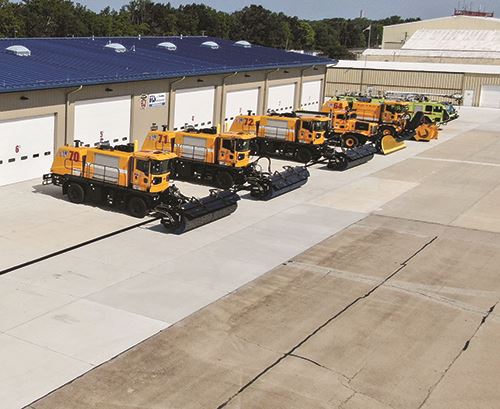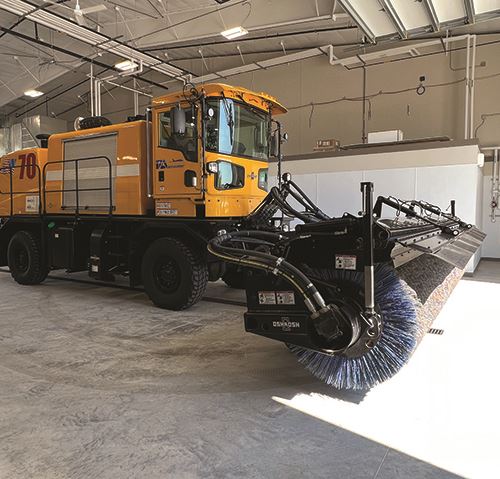No one had to convince Airport Director Tim Wright that Decatur Airport (DEC) desperately needed a new aircraft rescue and firefighting (ARFF) facility. He began his career at DEC as a firefighter back in 2004 and was well aware that its 1960s-era fire station was outdated.
No one had to convince Airport Director Tim Wright that Decatur Airport (DEC) desperately needed a new aircraft rescue and firefighting (ARFF) facility. He began his career at DEC as a firefighter back in 2004 and was well aware that its 1960s-era fire station was outdated.
 Wright was promoted to fire chief and then airport operations manager before being named airport director in 2014. So he knew the fire station unfortunately wasn’t the only antiquated facility at the commercial airfield. Its snow removal equipment facility was also outdated and insufficient to accommodate the Illinois airport’s growing needs.
Wright was promoted to fire chief and then airport operations manager before being named airport director in 2014. So he knew the fire station unfortunately wasn’t the only antiquated facility at the commercial airfield. Its snow removal equipment facility was also outdated and insufficient to accommodate the Illinois airport’s growing needs.
Airport leaders and the Decatur Park District, which owns and operates DEC, opted to address both needs with one project, and built a combination ARFF/snow removal equipment and maintenance facility. Construction of the centrally located 28,600-square-foot building was completed this July, and airport firefighters and maintenance workers moved into the new facility in August. It is a single-story structure that reaches 21 feet at its eaves, plus a mezzanine area.
|
Project: New ARFF Station & Snow Removal Equipment Facility Location: Decatur (IL) Airport Owner: Decatur Park District
Facility Size: 28,600 sq. ft.—single story Cost: $6.3 million Funding: Completely funded by Coronavirus Aid, Relief & Economic Security (CARES) Act Construction: Nov. 2021-July 2023 Consultant/Project Manager: Hanson Professional Services Inc. Design: Architectural Expressions General Contractor: Christy-Foltz Inc. Mechanical/Electrical/Plumbing Engineers: Architectural Expressions Technology Upgrades for ARFF Station: Forum Communications alarm system; conference center system for improved presentations & training ARFF Equipment: 2006 Oshkosh Striker 3000 with high-reach extendable turret; 2022 Oshkosh Striker 1500
Snow Removal Equipment: 4 runway brooms; Facility Features: Skylights; mezzanine-level training/conference room that will double as airport’s emergency operations center & backup location for county Emergency Management Agency; tornado shelter |
Long Time Coming
“This is a project we have been seeking for more than 11 years,” Wright relates. “Both of the old facilities were bursting at the seams. But we’re focused on operating cost-effectively. Instead of paying for the construction and upkeep of two different buildings, this was a way for us to house everything in one building and have only one set of utility bills.”
The $6.3 million project was fully funded by the Coronavirus Aid, Relief and Economic Security (CARES) Act, as was a new Striker 1500 fire truck the airport purchased in 2022. The new truck supplements the Index A airport’s existing Oshkosh Striker 3000.
On the snow removal equipment and maintenance side, the new facility houses four runway brooms, five plow trucks and two runway blowers along with a host of other equipment for the maintenance staff.
Hanson Professional Services Inc., an airport consulting firm headquartered in Springfield, IL, led the project management, and was supported by Architectural Expressions from nearby Forsyth, IL as the architect of record. Christy-Foltz Inc., a local Decatur firm, was the general contractor.
The old fire station, constructed in 1969, was on the south end of the airport. The new ARFF facility is more centrally located to decrease response time for runway emergencies. Longstanding T hangars were removed to make room for the new station/equipment facility.
One fire/rescue (operations) worker is always on duty at the facility. Wright offers additional coverage on weekdays, because he stays current with requirements for ARFF responders.
Updated Technology
One of the biggest benefits of the new facility is the upgrade in technology, primarily on the ARFF side of the building. A new incident alert and emergency response communications system from Forum Communications raises the bay doors automatically when the alarm sounds. The system also is tied into the local 911 emergency dispatch center, so it automatically communicates with other emergency services in Macon County.

The mezzanine level of the facility features a large conference room that can accommodate up to 50 people. Wright notes that its state-of-the-art technology could prompt the FAA and U.S. Department of Homeland Security to use DEC as a training center.
“From an operational standpoint, maybe we can have some training with the American Association of Airport Executives (AAAE) and host airfield training for other airports now that we can handle larger groups,” says Wright.
 Ryan Anderson, an Architectural Expressions principal, says his team worked closely with airport leaders and Hanson to ensure that the building’s design provided everything needed for technological upgrades, including a crash notification system, full generator backup power and alternate links to maintain communications with the National Guard tower and the air traffic control tower in the event of an incident. During the design phase, Anderson’s team communicated regularly with the airport to ensure that all of its requirements were met and building plans closely adhered to FAA design standards.
Ryan Anderson, an Architectural Expressions principal, says his team worked closely with airport leaders and Hanson to ensure that the building’s design provided everything needed for technological upgrades, including a crash notification system, full generator backup power and alternate links to maintain communications with the National Guard tower and the air traffic control tower in the event of an incident. During the design phase, Anderson’s team communicated regularly with the airport to ensure that all of its requirements were met and building plans closely adhered to FAA design standards.
Best Practices Approach
Some aspects of DEC’s new facility were modeled after a similar combination ARFF/snow removal equipment building at Southern Illinois Airport (MDH) in Jackson County. Personnel from Architectural Expressions joined DEC officials on a field trip to that airport before completing their design. The DEC structure is bigger than the one at MDH, but key components are similar, such as the configurations of bays for snow removal equipment.

Project planners had to squeeze DEC’s new facility into a tight location. Jeff Olson, aviation discipline manager at Hanson, notes that there were grade constraints on all sides of the building to cope with. Engineers also had to tie the facility into existing airfield pavement.
 “Situating a large building into a small site presented some challenges in terms of drainage, elevating the pavement and making all the grades in and out of the project work,” Olson remarks.
“Situating a large building into a small site presented some challenges in terms of drainage, elevating the pavement and making all the grades in and out of the project work,” Olson remarks.
Construction began in November 2021 and was completed this July. Pandemic-related supply chain issues caused a significant delay in obtaining steel needed for the building, but construction teams made as much progress as possible while waiting.
Olson describes the completed ARFF/snow removal equipment and maintenance facility as a bright addition to an already sterling airport.
“Not a lot of communities the size of Decatur have an airport with facilities like this,” he remarks. “The community is fortunate to have a regional airport providing general aviation, corporate operations, military and commercial air service.”

The new facility also houses airfield maintenance equipment.


 facts&figures
facts&figures

